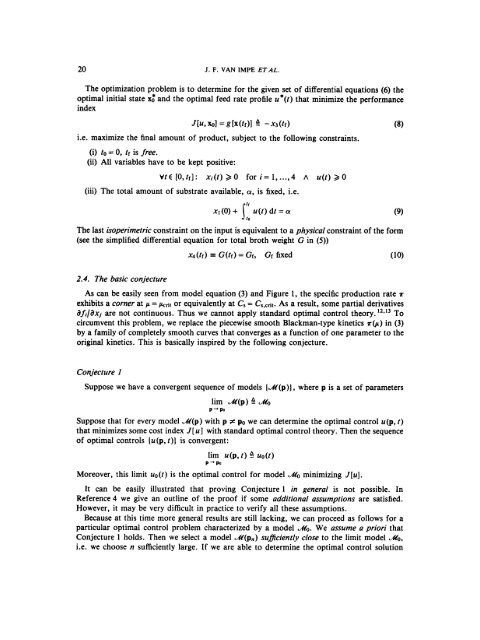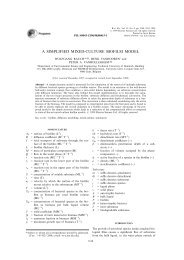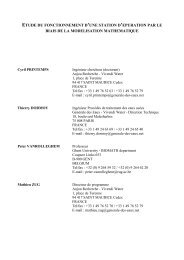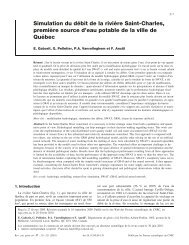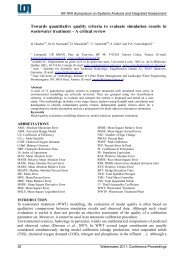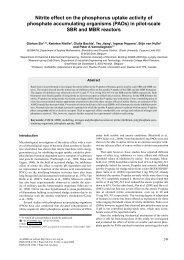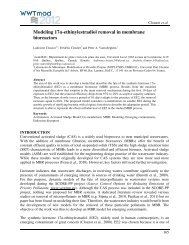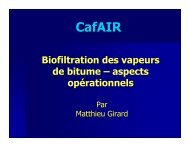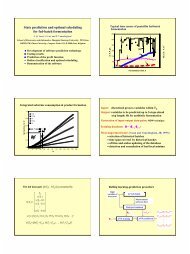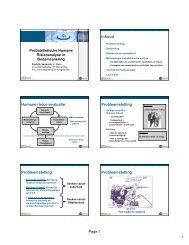Optimal control of the penicillin G fed-batch fermentation: An ...
Optimal control of the penicillin G fed-batch fermentation: An ...
Optimal control of the penicillin G fed-batch fermentation: An ...
Create successful ePaper yourself
Turn your PDF publications into a flip-book with our unique Google optimized e-Paper software.
PaPa20 J. F. VAN IMPE ETAL.The optimization problem is to determine for <strong>the</strong> given set <strong>of</strong> differential equations (6) <strong>the</strong>optimal initial state xo* and <strong>the</strong> optimal feed rate pr<strong>of</strong>ile u*(t) that minimize <strong>the</strong> performanceindexJ[u,xol =g[X(tf)l 2 -x3(tf) (8)i.e. maximize <strong>the</strong> final amount <strong>of</strong> product, subject to <strong>the</strong> following constraints.(i) to = 0, tf is free.(ii) All variables have to be kept positive:W E[O,tf]: Xi(t) 20 for i= 1, ..., 4 A u(t) 20(iii) The total amount <strong>of</strong> substrate available, a, is fixed, i.e.x1(0) + 1" u(t) dt = atoThe last isoperimetric constraint on <strong>the</strong> input is equivalent to a physical constraint <strong>of</strong> <strong>the</strong> form(see <strong>the</strong> simplified differential equation for total broth weight G in (5))2.4. The basic conjecturex4(tf) = G(tf) = Gf, Gf fixed (10)As can be easily seen from mode1,equation (3) and Figure 1, <strong>the</strong> specific production rate aexhibits a corner at p = pcrit or equivalently at C, = Cs,crit. As a result, some partial derivativesa fi/axj are not continuous. Thus we cannot apply standard optimal <strong>control</strong> <strong>the</strong>ory. Tocircumvent this problem, we replace <strong>the</strong> piecewise smooth Blackman-type kinetics rb) in (3)by a family <strong>of</strong> completely smooth curves that converges as a function <strong>of</strong> one parameter to <strong>the</strong>original kinetics. This is basically inspired by <strong>the</strong> following conjecture.(9)Conjecture ISuppose we have a convergent sequence <strong>of</strong> models (A(p)), where p is a set <strong>of</strong> parameterslim ~ ( p e ) 4P +Suppose that for every model A (p) with p # PO we can determine <strong>the</strong> optimal <strong>control</strong> u(p, t)that minimizes some cost index J[ul with standard optimal <strong>control</strong> <strong>the</strong>ory. Then <strong>the</strong> sequence<strong>of</strong> optimal <strong>control</strong>s (u(p, t)) is convergent:P +lim u(p,t) 2 uo(t)Moreover, this limit uo(t) is <strong>the</strong> optimal <strong>control</strong> for model Jtlo minimizing J[u].It can be easily illustrated that proving Conjecture 1 in general is not possible. InReference 4 we give an outline <strong>of</strong> <strong>the</strong> pro<strong>of</strong> if some additional assumptions are satisfied.However, it may be very difficult in practice to verify all <strong>the</strong>se assumptions.Because at this time more general results are still lacking, we can proceed as follows for aparticular optimal <strong>control</strong> problem characterized by a model 4. We assume a priori thatConjecture 1 holds. Then we select a model &(pa) suficiently close to <strong>the</strong> limit model &,i.e. we choose n sufficiently large. If we are able to determine <strong>the</strong> optimal <strong>control</strong> solution


